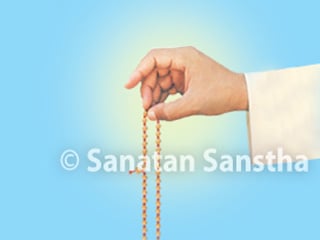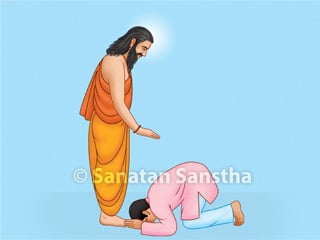
Contents
1. Sadhana (Spiritual practice)
One has to make efforts to experience bliss or attain Ishwar (God) in very this birth, which is called as sadhana (spiritual practice).
1.1 Sadhana (Spiritual practice) to attain Bliss
In this part of satsang, ‘Sadhana to attain Bliss’, we will be discussing about practical aspect of (Adhyaatm Shastra) Spirituality, that is sadhana. In the field of Medical science, one is recognized as a doctor only when he has studied the books (theory) and has given treatment to the patients, during his study time in the university. One can never become a doctor just by reading books. Similarly one cannot understand Dhyaan, Bhakti, Shraddha.. etc. by just reading about it. One has to undertake spiritual practice (sadhana) in daily life, to experience it.
In this part, we shall learn about the efforts that one should put in, to achieve final liberation. The first question that arises is, in this era, which is the simplest and practical method to attain the state of God realization? In other words, in Kaliyug (era of strife), which is the simplest way of spiritual practice (Sadhana)?
1.2 Which is the simplest sadhana in Kaliyug?
The simplest sadhana in Kaliyug is chanting (namajapa). Our four main Vedas, Upanishad, Shreemad Bhagwat Geeta, Shreemad Bhagwatpuran etc clearly explain the importance of naam sadhana.
नाम उपास्स्व । (छांदोग्योपनिषद ७/१/४)
In Chhandogyopanishad, it is said that
“Naam upaasavyaa. (Chhandogyopanishad 7/1/4)
Meaning: Chant (continuously)
Saint Tulsidas has said,
नामु सप्रेम जपत अनयासा ।
भगत होहिं मुद मंगल बासा ।।
सुमिरि पवनसूत पावन नामू ।
अपने बस करि राखे रामू ।।
Naanmu saprem japat anayasa |
Bhagat hohim mud mangal basa ||
Sumiri pavansut pavan naamu |
Apane basa kari rakhe ramu ||
Meaning: devotee can easily get immersed in the ocean of Bliss, when he chants with love. Son of wind Sree Hanuman won Sree Ram’s heart only by chanting His name continuously.
As per Rugved,
मर्त्या अमर्त्यस्य ते भुरि नाम मनामहे । (ऋ. ८/११/५)
Meaning: I, the non-last embodied soul, am always and continuously remembering that chant (naam), which is full of divine nectar.
महर्षीणां भृगुरहं गिरामस्म्येकमक्षरम् ।
यज्ञानांजपयज्ञोऽस्मि स्थावराणां हिमालय: ।। (श्रीमद्भगवत्गीता १०:२५)
Mahrsheenam bhrugurham giramsmyekmskarm |
Ydnaamjapayadnyosmi sthavaranam himalayaha || (Shreemad bhagwatgeeta 10:25)
Meaning: I am Bhrugu rushi in the list of all maharshee. I am one letter in any sentence, which means I am ‘Om’. I am sacrificial fire of chanting and amongst those, who are strong and stable, I am Himalaya mountain.
Meaning of chanting (naam jaap): Repeating the God’s name. The question that arises now is who should chant and which God’s Name should one chant? The answer is – we should chant the Name of God depending on the religion or sect of our birth.
There are various Gods-Goddesses in Sanatan Hindu Dharma. So which God’s Name should be chanted by Hindus? In the initial stages of sadhana, ideally which God’s Name should one chant? The answer is – one should chant their family deities’ (Kuladevta’s) Name.
Hindus should chant the name of their Kuladevata (Family Deity): The meaning of Kuldevata (Family Deity) is, the care taking deity of the family in which we are born. In Hinduism, every family has a particular Deity whose worship brings about worldly and spiritual progress for that family. Now let us see how to chant name of family deity. If the name of Kuladevata is feminine gender i.e. Kuladevi, then the chant is formed as follows. First say ‘Sree’, followed by the name of Kuladevi and then end with ‘devyei namah’. If the name of the Kuladevata is masculine gender i.e. Kuladev, then the chant is formed as follows. First say ‘Sree’, followed by the name of Kuladev, like ‘Ganeshay’ or ‘Maheshay’ and then end with ‘namah’.
Now let us see some examples to understand this
- If the Kuladevata is ‘Ambama’, then chant ‘Sree Ambadevyei namah’.
- If the Kuladevata is Ganeshji then chant ‘Sree Ganeshay namah’.
There can be some exceptions to this. For example, if your Kuladevata is Hanumanji, then you will have to chant ‘Sree Hanumate namah’. Please contact us in case you have any doubt about how to chant your Kuladevata’s name
Now you can start chanting. Please contact us in case you have any questions or have any spiritual experience during the chant. Our contact details are [email protected]
|
For more information on this article read Sanatan’s publication ‘Introduction to Spirituality’. |
Currently hard copy of reference book is available in: English, Marathi, Hindi, Kannad, Gujrati, Bengali, Gurumukhi, Malyalum, Telugu and Serbian.


 Karma-yoga
Karma-yoga Spiritual Practice
Spiritual Practice The Guru and Shishya (Disciple)
The Guru and Shishya (Disciple) Importance of spirituality
Importance of spirituality